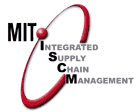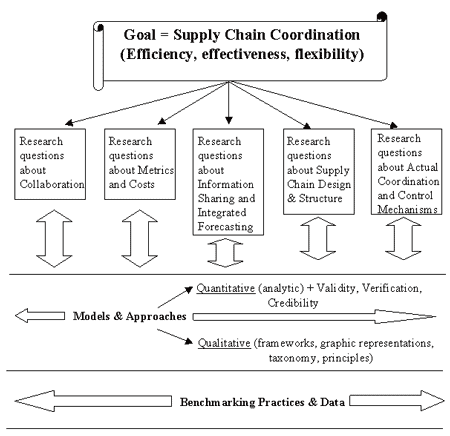|
|
 |
 |
 |
 |
 |
 |
Jointly hosted by
 |
& |
 |
Cambridge, Massachusetts
Coordinating Flows Across the Supply Chain
Meeting Summary
Research Colloquium Review
This event joined ISCM sponsors
with Leaders For
Manufacturing (LFM) partners for a focused discussion on supply
chain research. The event entailed LFM intern research progress
reports, an ISCM supply chain presentation and a discussion
to develop a common research interests.
The morning of the colloquium consisted of research progress reports
from 5 LFM interns working on supply chain research projects for
LFM Partner companies. The projects each have an aspect of
coordinating the various flows across the supply chain (hence, the
title of the colloquium). See below for the list of LFM intern
presentations, along with a brief descrition of the nature of the
project.
After the presentations, Mary Murphy-Hoye of Intel shared an overview
of Intel's supply chain along with suggestions for our research
focus. Participants were separated into three groups of approximately
9-10 people to discuss and provide input to the following questions/topics:
- Question one: Supply Chain Challenges
- Question two: Identify common needs
- Question three: Identify potential actions and projects
Research Interest Summary & Synthesis
A group exercise (break out groups, see details after graphic) helped
surface common research interests, which have been organized in
a framework as pictured below.

The five (5) sets of research questions each respectively seem to
support the (draft) goal of "Supply Chain Coordination" (for which
we added several elements of efficiency, effectiveness and flexibility).
Several issues seemed to apply equally to each of these research
questions, and they have been categorized as cross-cutting elements
of this framework
- Models & Approaches
- Benchmarking Practices & Data
Break Out Group Work
Participants were separated into three groups of approximately 9-10
people to discuss and provide input to the following questions/topics:
- Question one: Supply Chain Challenges
- Question two: Identify common needs
- Question three: Identify potential actions and projects
These are the summaries from each of the three groups.LFM-ISCM
Sub-Group Summary (Graves)
- Challenges:
- Understand best material control policies: pull, push,
conwip, MRP
- Understand conflicting metrics and different goals across
supply chain, especially as they inhibit collaboration
- Understand how to use IT to make information useful,
consistent and accessible to all members of supply chain
- Needs
- Principles for supply chain design, including ownership,
geography, channel, operational mechanisms
- Quicker, better ways to evaluate decision options on inventory,
capacity, products, networks
- Ways to define customer value from a (coordinated) supply
chain
- Better ways to transform or filter data (or information
or knowledge) for business use
- Projects
- How much and what type of information to share across
members of a supply chain?
- What's the role of collaboration in seeking supply chain
coordination?
- Understand relationship between product proliferation
and supply chain costs
- Understand how to apply supply chain research, e. g.
inventory models, capacity models, and how to match supply
chain models to various contexts, depending on degree of
product proliferation, channel structure, process types,
…
- Determine if (or when) the Hub concept is value added·
Develop criteria and models for supply chain design and
evaluation
LFM-ISCM Sub-Group Summary (Hanson)
Our Breakout group recommended 5 areas for further Supply Chain
research and/or areas whereby the collaboration of MIT and Industry
partners can provide a significant benefit.
- Development of robust Supply Chain models for the total enterprise.
- Recommended package of proven supply chain tools and/or best
practices. eg Decisions Support tools
- How to determine the points of profitability in the enterprise
wide supply chain and how to share that profitability across
all the participants based on their contribution to that profitability.
eg. in order to optimize profitability and business performance
of the total supply chain, some partners may incur increased
costs and/or higher levels of supporting assets (inventory and
capital equipment) and therefore lower individual ROA performance.
- Enterprise wide supply chain metrics. Measurements that allow
a company to compare the performance of their total supply against
the performance of another company's total supply chain. This
is driven by the recognition that even though their company
may be currently enjoying good individual financial and business
results, that those results are at risk if the performance of
the total supply chain is below the performance of competing
supply chains.
- Forecasting tools. Even with the ability to use truly integrated
supply chains with instantaneous sharing of knowledge and information
of orders to all members of the supply chain which will allow
true total build to order for all participants, forecasting
will still be necessary for future capacity and resource planning.
These research themes were driven by the need for improved performance
by most of the members of the group in the following areas.
- Improved Forecasts
- Integration:
- functions within companies
- company to company
- processes that can freely link across organizational
and company boundaries
- Metrics and performance benchmarks that optimize the total
supply chain
- Overall supply chain results and benefits vs individual
companies
- lead time vs volume
- inventory vs reduce waste (time and assests)
- Information systems that link across organizational and corporate
boundaries
- Determining the economic valued added in the supply chain
and how to properly reward that value added.
- Success in selling modelling and simulation. How to educate
their organization and supply chain partners to use and trust
simulation.
LFM-ISCM Sub-Group Summary (Rosenfield)
| Question one: Challenges |
- Producing to schedule given competing objectives
- Forecasting accurately
- Configuring to order
|
- Collaboration with suppliers and customers
- Reducing lead times
- Sharing information vs. collusion
- Demand and capacity mgm
|
| Question two: Common needs or agenda |
- Taxonomy or set of visualizations for types of supply
chains
- Process to integrate information systems
- When, how and benefits from collaboration, including
structures
- Collaboration that goes beyond sharing information
- Share design
- Help reduce lead times etc.
- How to share information given legacy systems
- Perfect information not always what we think
|
- How to gather and use POS data
- How to share power
- Dealing with short prod. life cycles
- Right inv. at right place at right time
- Approaches to relate and match
- Capacity
- Inventory
- Lead times
- Demand by part across the entire supply chain (to the
left)
|
|
Question 3: Actions and projects
|
- Taxonomy & visualizations for SCs that break down
approaches by problem type
- Inventory and capacity placement for different types
of chains for entire chain
- Where to place inventory
- How long to respond to changes
- How to deal with perturbations
- How to allocate capacity
|
- Benchmarking
- Collaboration needs
- Review of software packages for collaboration
- Incentive structures and contracts including examples
- Modeling different types of information sharing
- Improved forecasting models and best practices including
which techniques work best for different situations
|
Summary
|
September 17, 1999
MIT Faculty Club,
Cambridge Massachusetts
|
| »
|
LFM Intern Research Midstream Project
Reviews
-
Asea Brown Boveri
- Supplier Coordination
Miriam Park - MIT LFM Intern
at ABB
Miriam Park: This project is part of a larger
effort in ABB's Gas Turbine Division to
design and implement a Supply Chain and
Logistics management system to synchronize
demand driven market pull with supply chain
constraints. This internship specifically
analyzes the current supply chain, recommends
improvements to coordinate the supply chain
and joint systems, quantifies the impact
of design changes on manufacturing and logistics,
and develops tools and metrics to monitor
the supply chain performance.
-
Alcoa Distribution
and Customer Coordination
Brian Urkiel - MIT LFM Intern
at Alcoa
Brian Urkiel: A Belgium warehouse acts as
a service center linking Alcoa's U.S. operations
and its European customers. For sheet and
plate products produced in Davenport, IA
there is a wide gap between the customer's
actual consumption rate and the manufacturing
facility's minimum order quantity. To overcome
this and to buffer against variability in
production yields, customer demand, lead
times, the Alcoa Mill Products (AMP) supply
chain is forced to maintain large amounts
of inventory. Currently there is no methodology
in place to engineer inventory levels by
product for each European customer which
optimize the entire supply chain. This internship
analyzes the entire AMP supply chain and
identifies the primary reasons why inventory
is being carried. This internship assesses
existing stocks, mill production parameters,
and end customer requirements to develop
a methodology to optimize inventory levels
for entire AMP supply chain while meeting
desired customer service levels.
-
Compaq - Component
Supplier Coordination
Mitch Malone - MIT LFM Intern
at Compaq
Mitch Malone:Compaq's Alpha Server supply
chain will be used to identify the issues
Compaq and MIT should assess to improve
a supply chain through an ongoing project
in this area. A Model of this supply chain
for memory components will be built to assist
in cost and quantity decisions.
-
Kodak - Internal
Coordination of a Vertically Integrated
Supply Chain
Scott Pagendarm & James Ryan Horn
- MIT LFM Interns at Kodak
James Horn and Scott Pagendarm: This project
is undertaking initiatives in Kodak's film
sensitizing operations to bring customer
demand signals to directly to early steps
in manufacturing, to reduce lead times by
re-evaluating testing procedures, to optimize
policies for batch size and inventory holding,
and to model strategies for managing seasonality.
-
Intel - Capacity
& Throughput Management
Tony Newlin - MIT LFM Intern
at Intel
Tony Newlin: Intel's assembly and test factories
utilize the Theory of Constraints to manage
output and through put times. The application
of the theory involves a combination of
WIP buffers and excess tool capacity. The
factories face frequent changes in product
mix and maturity which result in large swings
in available capacity. This dynamic combined
with increased cost reduction efforts has
led to a need for more accurate capacity
planning. This internship employs discrete
event simulation of an entire manufacturing
line to optimize excess tool capacity requirements
and WIP policies.
|
| »
|
The Intel Supply Chain
Mary Murphy-Hoye - Director - IT Strategy
& Technology (prsenting for Gordon McMillan
- Director of Supply Network Strategy)
Intel Corporation
|
| »
|
Research Discussion
- Common Issues & Themes
Subgroups of Sponsors and MIT Faculty
& Researchers
|
| »
|
Research
Discussion - Collective Common Issues & Themes:
Next Steps
ISCM & LFM Sponsors, MIT Faculty
& Researchers |
| »
|
|
|
|
|
 |
 |
|

